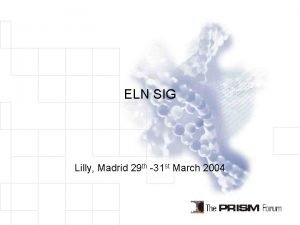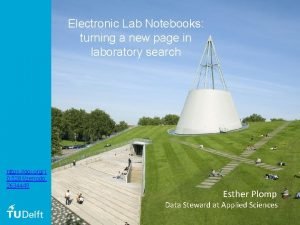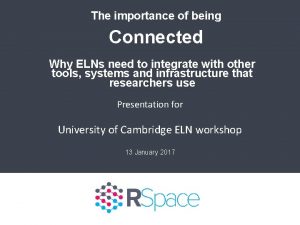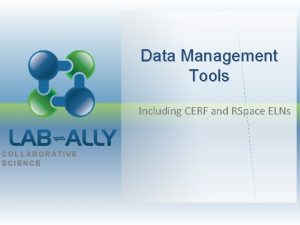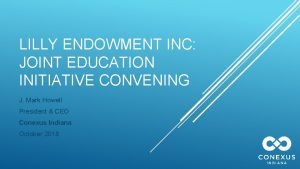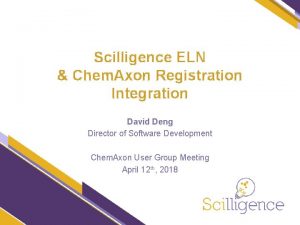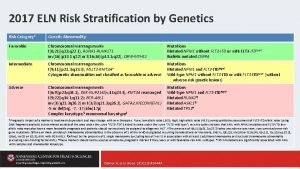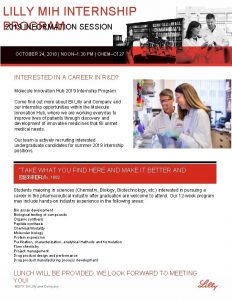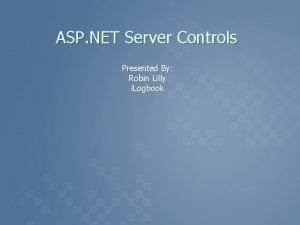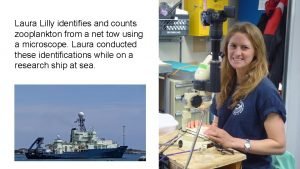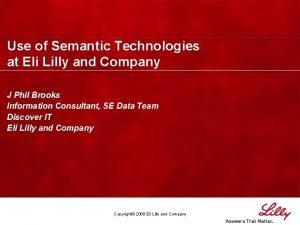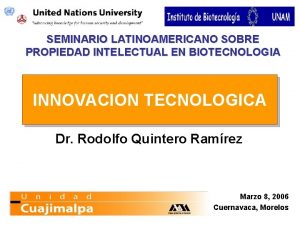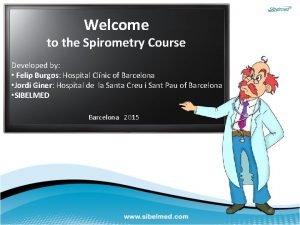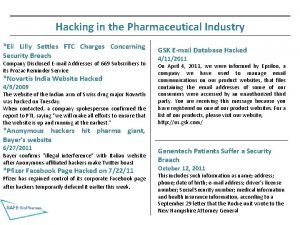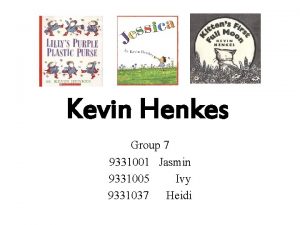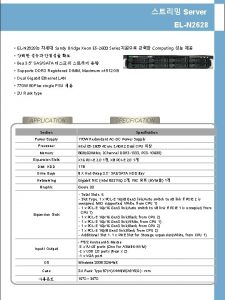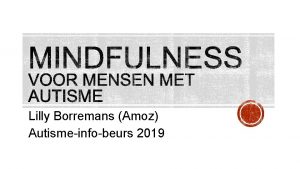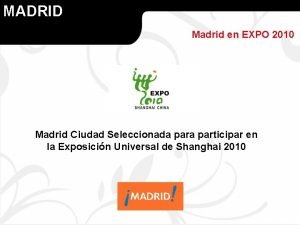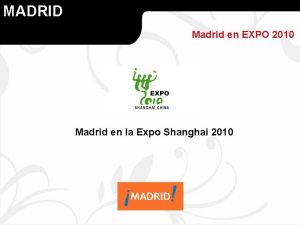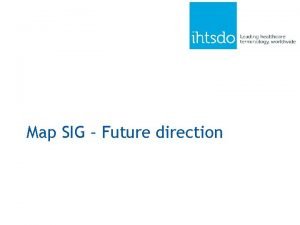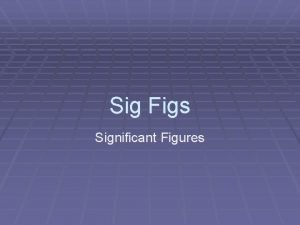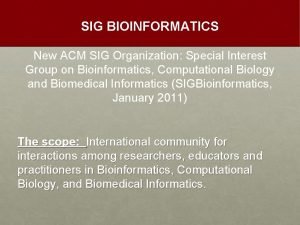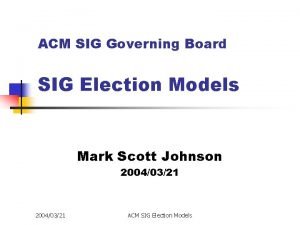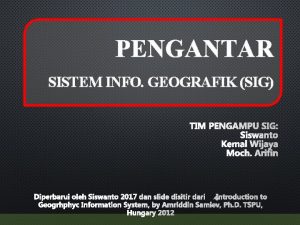ELN SIG Lilly Madrid 29 th 31 st




















- Slides: 20

ELN SIG Lilly, Madrid 29 th -31 st March 2004

Participants • Bo Skoog, Biovitrum • Martin Waligorski, Guide • Joerg Schmiedle, F. Hoffmann-La Roche • Bev Eccles, Wyeth • Juliana Lau, Glaxo. Smith. Kline • Danny Verbinnen, Johnson & Johnson Pharma R&D • Uwe Trinks, Sentrx • Howard Bilofsky, U Penn • Mats Kihlen, Biovitrum • David Drake, Astra. Zeneca • Simon Bailey, Syngenta • Ron Behling, Bristol Myers Squibb • Robert Herouet, Lilly • Daniel Garcia Fuentes, Lilly • Rowan Gardner, Bio. Launcher

Presentation Outline • • • ELN Drivers Definitions Requirements Benefits Challenges Current approaches • • ELN options Architecture Way forward Conclusions

Electronic Laboratory Notebooks The traditional way – use paper notebooks – book shelves / file cabinets / microfilm The alternative way – implement a tool and a process – computer repository • The heart of scientific work is to keep track of ideas, experimental setups, observations, research results. . .

ELN Drivers • Improve IP protection – Completeness and compliance • Knowledge sharing – Reduce repetition of failed activities – Capture best practice – Identifying new opportunities • Efficiency – Personal efficiency – Information flow • Data capture and information management

ELN Definition • A fully electronic notebook is a system to create, store, retrieve and share fully electronic records in ways that meet all scientific, legal, regulatory, and technical requirements. • A hybrid electronic laboratory notebook is a system to create, store, retrieve and share electronic records, which uses printed copies with handwritten signatures for archiving and IP protection. • Records are the collection of information or data associated with an experiment to enable a suitably skilled person to repeat it. records also contain a time and date-stamp.

Key Requirements: Scientists • • capture information independent of source and format clearly associate a record with the originator import/export data supports scientists’ working practices (including reuse) fully searchable link to other systems retrieve and share records over time support document life cycle stages – private / in progress, public / finalized, and archived • supports element referencing within experiments • user acceptance; better than the paper counterpart

Key Requirements: Other Stakeholders • LAWYERS/REGULATORY – ability to show in court records, & audit-trail – support for due diligence – IP protection – validated records when applied in regulated situations – Completed records, nondeletable • ARCHIVISTS – compatible with corporate archiving and retention strategy – longterm retrievability of records – human readability over time • MANAGEMENT – ability to generate business process metrics – improve quality – facilitates collaboration and share information – provide the ability to use, mine, extract and compile information – be compatible with corporate strategies – drive process improvement

Benefits (company perspective) • IP protection • – Capture ideas, and creative process – Completeness of records – Reduce litigation cost by improved access to the data – Establish an earlier priority date • • – Easier to capture varied data types (don’t glue things into lab notebook) – No need to manage paper lab notebooks – Use of forms and templates (iconic, reusable text, etc) makes data entry easier – Drives improved workflow – Integrating other components enables more rational use of other components and services – Avoid duplication of failed assays and synthesis – Avoid reinventing protocols – Better design of experiments Quality – Records are complete – Quality of information recorded improved – Structured information – Easier to be more verbose and capture additional information – Improved calculation – Readable – Audit trail – Metrics Disaster recovery Productivity increase • Sharing – Sharing information among different business components (e. g. Disc to PD) – Packaging of information for 3 rd parties

Benefits (scientist perspective) • Productivity increase – Same as above • Searchable – Access to previous experimentation => reuse of experimental methods, ideas, outcomes, equipment evaluations – Ability to understand results of experiments – Support for legal requirements – Organizational productivity enhancement • Sharing – reuse of experimental methods, ideas, outcomes, equipment evaluations – Information about running the experiment and the conclusions derived from the data • Integration of systems – – – Compound registration Analytical systems Compound management Workflow management Image systems (f. MRI, gene expression) Analysis tools

ELN Challenges • Cultural aspects – – – – Slow Adoption Root-cause of Resistance Workplace Disruption Security – – – Electronic Signature Standard Repository Security Archival Records Format Inter-application Credentials Records with Open & Restricted Data Third Party Access Integration – Custom Applications / other ELNs – Compound Registration & Request – Experimental Request & Data Systems – Vendor Databases – LIM Systems – Tight integration for robust information sharing with loose coupling with other systems – Must have a clear business strategy and IT architecture Sharing information New SOPs / work practices Computer literacy Part of the workflow Need strong management champion Acceptance of electronic paradigm across the business Workflow Inertia • • • Managing scope and expectations – Establishing ROI and commitment to funding – Phased implementation • Scalability – – Growing User Population Variable Loading Potentially Highly Integrated Frequent Data Mining Target

ELN Challenges • Persistence – Indefinite (~50 yrs) Retention Policy – Platform Neutral Record Format – Separable Record Elements – (for Searching and Accessing) • Flexibility – – • • Diverse Workflows Continually Changing Workflows Centralized & Personal Styles Variable Software Environment Logistics; Practical implementation in the lab Change • Politics – – • Immature Products – – • Strong Leadership Required Inter-departmental Cooperation Proprietorship of Data Perceived Productivity Monitoring Unstable Base Frequent Releases Changeable Marketplace Incomplete Understanding of Science Ease of adoption – Easy to learn – How to make a complex system easy to use

Top ELN Challenges • • • Cultural aspects Managing scope and expectations Integration Evolving products Persistence ? CHANGE

Current Approaches

Current Approaches

ELN Options Scope • Build – Risk management – A chance to fit requirements exactly and control future – Plan for integration – Requires resource and skills • General or Discipline specific • Buy – – – Risk management Does not fit all requirements Integration challenges Immature products Future vendor viability • Hybrid or fully electronic Fit with wider IT Architecture Considerations

Architecture • ELN is primarily a workspace for data assembly and record creation • Separate ELN interface from records management function – ELN Workspace/GUI for content assembly – Publish records – Record management is a corporate service • Paper/electronic/hybrid • ELN becomes an enabler/ productivity tool for investigators • application integration with other tools • data integration

Architecture

Steps towards an ELN installation • Define what other systems exist or should be created first – Avoid wrong expectations. ELN may not be your biggest problem. – e. g. Compound registration, sample logistics, chemical inventory • Define the IT architecture for data sharing – Use this as requirements for any purchasing or in-house development project • Create a master plan for desired final system – Start with component architecture – Applications, meta-data, database and records management • Set realistic scope for pilot implementation – Avoid solving all problems at once – Identify driving forces, allow iterative improvements – Keep final architecture in mind and don’t deviate from it

Conclusions • Business drivers support implementation in near future • Requires a ELN strategy now • Challenging but mission critical
 Lilly madrid
Lilly madrid Indigo eln
Indigo eln Rspace eln
Rspace eln Labally
Labally Agbio eln
Agbio eln Scilligence eln
Scilligence eln 2017 eln risk stratification by genetics
2017 eln risk stratification by genetics Eli lilly mih internship
Eli lilly mih internship Would you rather pills
Would you rather pills Adalabek
Adalabek Laura lilly
Laura lilly Lilly
Lilly Lilly
Lilly Eli lilly productos
Eli lilly productos Spirometer
Spirometer Lilly settles
Lilly settles Lilly's purple plastic purse summary
Lilly's purple plastic purse summary Lilly medina
Lilly medina Colonel eli lilly quotes
Colonel eli lilly quotes Llegamos donde otros no llegan
Llegamos donde otros no llegan Rizal's salute to luna and hidalgo summary
Rizal's salute to luna and hidalgo summary
